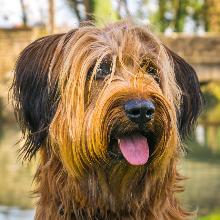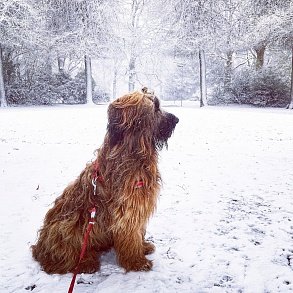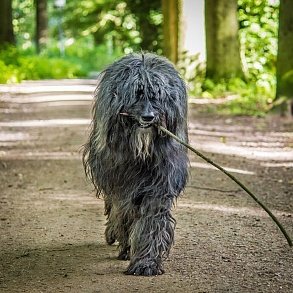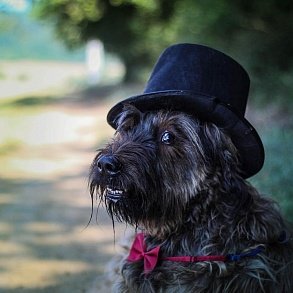Briar

Briard is a French shepherd shepherd with long hair all over the body and stylish shaggy bangs on the forehead, hiding the eyes. Among breeders, it is valued for its sharp mind, vivacity of character and independence in decision-making.
Brief information
- Breed name: Briar
- Country of Origin: France
- Weight: males 30-40 kg, females 25-35 kg
- Height (height at the withers): males 62-68 cm, females 56-64 cm
- Life expectancy: 11-13 years
Highlights
- Briard is smart, savvy and perfectly aware of his own strength, so in the process of learning he often tries to insist on his own.
- The long, dry coat of the dog almost does not shed, but it intensively gets into tangles. So if you do not want your pet's body to turn into a solid untidy "felt boots", do not neglect its daily combing.
- Despite the somewhat weighted complexion, briars are very frisky creatures. The running Shepherd is fast-elegant and demonstrates almost feline grace in movement.
- In everyday life, representatives of this breed are calm and friendly, but only if their owner is a person with pronounced leadership qualities. Owners who do not have experience in raising dogs with a dominant character should not train on Briar sheepdogs.
- With proper training, the briar can easily transform from a shepherd into a responsible watchman who will never give up positions and will protect the owner's home and his property to the last.
- Briars don't stand on ceremony with other dogs, so if another "tail" gets into the field of view of the animal, get ready for a conflict, or even a serious fight. With cats, things are almost the same, with the exception of Kotofey, with whom the dog spent his childhood and youth.
- The worst thing you can think of for a briar is to make him compete for the owner's affection with other pets. For pets that are inferior to the shepherd in size and cunning, such experiments end, as a rule, sadly.
- Briar is a very energetic breed that retains an interest in active entertainment until old age, so do not expect a dog of "retirement" age to be sedate and imposing.
Briar is an energetic dog with a bright, memorable image and a really strong character. Having made a reputation on his outstanding abilities for pastoral work, the shaggy intellectual has always been distinguished by an amazing love of life, developed intuition and the ability to win over a person. To get along with briar means not trying to educate him to fulfill his momentary whims, because this stylish cute guy is ready to serve, but not to serve in any way. In addition, you will have to take into account the possessive habits of the breed: briar is the dog that will not leave room in your heart for another fluffy.
Breed characteristics
History of the Briar breed
Already in the XII century, French farmers were in close contact with the ancestors of briars, who were attracted to graze sheep flocks. However, at that time, representatives of this dog family were called Briar sheepdogs – after the name of the province of Brie, in which they were allegedly bred. Large, massive animals were valued by the peasants mainly for their independence and ability to lead the herd without looking back at the owner. For example, a properly trained dog could cope with a flock of sheep alone, driving him out to graze in the morning, and in the evening collecting cattle and escorting him from the field.
The first more or less truthful description of the appearance and character of Briar Sheepdogs was compiled in 1809 by Abbot Ronier. In his agricultural treatise, the clergyman described dogs as excellent shepherds and tireless defenders of farm property. By 1885, the briars' efficiency and intelligence were so advertised that the animals were granted the status of an independent breed, and two years later a separate standard of appearance was approved for them. But the real popularity overtook the shepherds during the Second World War. In the conditions of a protracted war, these shaggy stalwarts proved themselves as a cheap draft force, so for several years they took the wounded from the field, and also delivered shells to the trenches, which is why they almost disappeared as a breed.
In 1924, French specialists set out to restore the number of briars and founded the first shepherd lovers club. Since that time, animals have ceased to be considered exclusively as peasant dogs, thanks to which they have moved into a more elite "caste" of companions and athletes. In the middle of the XX century, the Briars began to expand the boundaries of their own popularity, emigrating to the rest of Europe and North America. However, the New World was not interested in the breed for unknown reasons, so the vast majority of its representatives continued to live in Western European countries. In the Soviet Union, they learned about briars with some delay, at the end of the 80s, but they made up for lost time at a rapid pace. In particular, already in 1991, domestic breeders were bragging to their foreign colleagues about the first "made in Russia" puppies.
Famous briar owners:
- Napoleon Bonaparte;
- Charlemagne;
- Alexander Maslyakov.
Video: Briar
Briar's appearance
Briar is a charming disheveled man with hipster bangs, wrapped in a long, shaggy "fur coat". The sexual type of representatives of this breed is pronounced vividly, so Briar bitches are noticeably smaller (average height – 56-64 cm) and more elegant than males. At the same time, the boys also do not differ in excessive bagginess and are quite graceful.
The deceptive carelessness and simplicity of the briars' appearance is actually the result of many years of work by breeding specialists. What is it! French breeders are shaking over their wards, as over a real living rarity, in an attempt to preserve the original appearance of dogs and by all means avoid the slightest changes in their image. Perhaps that is why in the breed standard more space is given to the enumeration of possible defects and defects of Briar Shepherds than to the description of their exterior features.
Head
Briar's head is elongated, with a rounded forehead and a rather steep foot.
Teeth and jaws
The purebred Shepherd has a full set of 42 snow-white, strong teeth. The standard type of bite for the Briar breed is "scissors".
Nose
Straight, without hump or dip, briar's nose ends with a square black lobe.
Eyes
The dog's large, dark eyes are set straight, without tilt. The steel color of the iris is acceptable only for individuals with gray hair.
Ears
The ears of Briar Sheepdogs have been docked since ancient times, which is why the ear cloth assumed a standing position. Today, the EU countries have abandoned this procedure, so modern French briars have short, high-set and slightly adjacent to the head ears. In Russia, cupping has not yet outlived itself, but when buying a puppy whose ears have already been worked on by a veterinarian, remember: it is better not to show up at European exhibitions with such a briar.
Neck
Briar's strong, muscular neck resembles a truncated cone in shape and smoothly grows into shoulders.
Housing
The body of the dog is somewhat stretched, with a massive chest, a straight back and an inclined, rounded croup.
Limbs
Both the front and rear legs of the briar are very strong, muscular, placed strictly vertically. Hock joints with moderate angles, not too low. Paws are strong, resembling a cat's, with elastic pads. The claws are black. A distinctive feature of the breed is double dewclaws on both hind limbs.
Tail
The briar's tail is carried low, bending at the end into a hook.
Wool
Dry, long shepherd hair resembles goat hair in structure.
Color
Briar can have any solid color type, except white, chocolate and mahogany shade. At the same time, preference is always given to darker individuals at exhibitions. It is acceptable if the hair on the dog's legs has a lighter color than the hair on the rest of the body.
Disqualifying vices
- Height above or below the specified standard by more than 2 cm.
- Brown or pink lobe.
- Severe undershot.
- Absence of any three teeth or two lower fourth premolars.
- Raznoglazie. The eyes are too light a shade.
- Too low-set ears with folds or fused cartilage.
- Non-parallel postage of the hind legs.
- Vertical position of the tail or tail thrown on the back.
- Claws of white color.
- Incomplete set of dewclaws or their complete absence.
- The length of the coat is less than 7 cm, the hair with a pronounced curl, too soft.
- Presence of white spots on the body and white hairs on the paws.
- Fawn with black color, the presence of a black "cloak" on the body of the shepherd.
Photo of briar
Briard's character
Briar is a dog, complicated in every way. On the one hand, he is a devoted pet who dotes on his own master, and on the other hand, he is the greatest manipulator who will never agree to a secondary role in your life. The external charm of briars is something beyond description! Begging glances, flirtatious antics, full of comic charm facial expressions – these French rascals have a whole arsenal of various tricks in stock that allow them to get what they want. By the way, it is on the off-scale mimicry of the breed that most inexperienced owners have burned, because as soon as briard realizes that his skillful pantomime amuses you, he will turn into a cunning and naughty pet.
Oddly enough, but a pronounced authoritarian style in dealing with these shaggy pets does not work either. Briard absolutely cannot stand it when they try to suppress his will or, even worse, begin to urge them. In the eyes of the dog, this behavior looks like a form of mockery, which she will never forgive you. Yes, the pet does not mind at all that he was pointed out to the proper place, but this should not look like a violation of his personal dignity, which is somewhat hypertrophied among representatives of this breed.
Briars perfectly sense the mood of the owner and often copy his behavior, so if you are used to sorting things out with your family in raised tones, do not be surprised that the shaggy "monsieur" will try his best to participate in them, that is, grumble and bark loudly. As for the dog's intelligence, like a human, it requires constant development, so load your pet with useful activities that require a certain ingenuity more often. For example, instruct briard to bring you a mobile phone whenever it rings, or teach him to get the morning newspaper out of the mailbox.
If you are too lazy to engage in intellectual education of briard, get ready for the fact that he will develop his own "training course" for himself, and you will rake out the consequences of such exercises for a very long time. For example, Briar Sheepdogs are excellent at opening all kinds of lockers and extracting their contents, and they are also always ready to face off with other males or chase cats.
Briars are jealous and touchy. Take this as a given and do not provoke the animal without any reason. This "Frenchman" will forgive his master a lot, but not ostentatious love for some cat or pug. And by the way, even if you bring a second briar into the house, this will not improve the situation at all, since each of the dogs will try to attract the owner's attention to themselves. Are you ready to be torn between two shaggy "hipsters" 24 hours a day? Then go ahead! In dealing with strangers and unfamiliar people, briars are reserved, if not suspicious, so when you see one of these shaggy–haired sympathizers on the street, do not rush to pat him on the head - suddenly he is in a bad mood today.
Education and training
Briars are extraordinarily memorable, understanding, but not devoid of stubbornness, students who need a special key. By the way, to apply punishments to them, especially physical ones, means only to worsen the case and permanently lose their trust. In the shower, you can scold the shepherd as much as you want, but do not allow yourself to take out your irritation on her. Briard was not born to blindly obey instructions. This is a thinking dog, with its own views on life in general and on training in particular. But if the pet at least once executed the command as required by the rules, do not doubt, he will not forget it and will easily repeat the "feat" even after 2-3 months.
The desire to dominate and take the place of the owner for briars is a completely normal phenomenon. Moreover, if the males immediately go ahead, asserting their own authority, then the bitches act by deception, coming up with clever strategies to circumvent the rules. If you notice that it becomes difficult to cope with a dog, entrust its training to a professional – save your nerves and do not start the animal.
If we are talking about training courses, then with briars, OKD (General training course) and UGC (Controlled urban dog) are most often passed. In addition, sheepdogs have a clear tendency to sports disciplines such as agility, freestyle, skidjoring and weightpulling. The course of IPO (International System of Obedience) briars also click like seeds, and, unlike most other breeds, these "Frenchmen" are able to master new knowledge at any age. And of course, do not forget about the main qualification of the breed – pastoral service, tests for which briars usually pass with the highest score.
It is possible to drive a dog to the training ground from 6-7 months, and training in elementary rules of behavior and the simplest commands is allowed to begin at the age of 4 months. The best way to socialize a briar puppy is to walk with him along busy streets so that the baby stops being afraid. To make a pet love other dogs in this way, of course, will not work, but to help him come to terms with the inevitability of their presence in his life is quite real. Owners of briars are recommended to wind a leash on their hand and walk their wards in places of maximum concentration of dog lovers and their four-legged pupils.
Maintenance and care
Despite its rather impressive dimensions, Briar is not a yard shepherd and living in a booth, especially in the cold season, is contraindicated for him. The breed's habit of a mild French climate has not gone away. For the summer, the animal can be moved to an aviary, where it will be quite comfortable. Regarding apartment maintenance: everything is not as difficult as it seems at first glance. A properly educated briar does not rush headlong around the apartment and does not make a mess, which means it does not take up so much space. However, it is worth walking such a dog longer, and even better – to enroll it in some training course where it can run for its own pleasure.
Hygiene
Briard's long, dry hair does not shed in the full sense of the word, it just forms tangles. But since it is not customary to trim representatives of this breed among dog owners, they will have to be combed often and thoroughly. First, the wool is worked through with a rare comb to remove the debris entangled in it and partially break up the fallen areas, after which a massage comb or a comb with frequent teeth are passed over the "fur coat". If the moment is missed, and the tangles still appeared, try to disassemble them. Arm yourself with a koltunorez only as a last resort, when the matted wool is no longer amenable to untangling.
Important: brushing the briar "on dry" can spoil the structure of its coat and expose the dog to additional stress. It is necessary to use an air conditioner designed to facilitate this procedure.
The dog's mustache and beard are also combed regularly. In addition, you will have to constantly monitor their cleanliness, since they invariably get dirty during feeding. Stylish bangs on the head of a shepherd dog are not cut, but if the hair grows too intensively, it is slightly milled (thinned) with hairdressing scissors and pulled together with a rubber band. However, if you keep a dog for the soul and are not going to storm the exhibition, the hair can be shortened a little. The main thing is that after the haircut, the briar is guessed in the dog, and not an overgrown lapdog. It is necessary to cut the hair between the fingers, which quickly gets dirty, gets into lumps, interfering with the animal when walking.
Frequent bathing briars are not recommended, because they lead to uncontrolled undercoat discharge, so if your ward lives in the house, periodically sitting in the yard aviary, wash it once every couple of months. Capricious "citizens" living in apartments can be bathed more often, about once or twice a month. By the way, at the same time, get ready to smell a specific smell, since briar's wet hair strongly smells of sheepskin. As for the exhibition specimens, it is better to wash them not on the eve of the event, but at least a week before it.
Do not forget about high-quality cosmetics, without which the wool of these charismatic "monsieur" will not be so airy and shiny. This means that from time to time you will have to unfasten not the smallest amounts for shampoo, conditioner, cream to facilitate combing and other grooming lotions that give the dog's hair gloss and the necessary softness.
Briars' eyes and ears do not need specific care. Just keep them clean using a standard arsenal of remedies: ear cleaning lotion, cotton swabs, chamomile infusion to relieve minor eye inflammation. The exception is dogs with uncapped hanging ear tissue, having a tendency to otitis media. For such individuals, standard cleaning will not be enough, so to improve ventilation, they will have to thin out their hair in the ear canal. The claws of Briar sheepdogs are cut as they grow, with a guillotine-type claw cutter, which is less likely to injure the dog.
Feeding
Briars are not picky in food and do not need delicacies. A healthy dog that receives the right loads is ready to be content with stringy meat scraps and offal mixed into buckwheat, oatmeal or rice porridge. Sea fish of the cod family can also be briar, but not more than once a week. A great addition to the main diet of the dog will be low-fat dairy products, vegetables (carrots, squash, pumpkin), greens from the garden. Kelp and vegetable oil (1 tablespoon) are suitable as additional sources of macro- and microelements.
Naturally, we must understand that with such a monotony of the menu, briar will need mineral fertilizing from the vetapteka. In particular, the owners of animals that do not differ in the richness and quality of the coat, opt for complexes with vitamin B, biotin and methionine. Do not rush to the other extreme, feeding briar with all the existing vitamins. Bags of dietary supplements will not help to turn a pet into an ideal dog, but they will easily and quickly plant his liver.
How many times to feed
A two-month-old briar is fed up to 6 times a day, reducing the number of meals as he grows up. At 8 months, puppies are completely transferred to an adult diet and two meals a day. Sedentary adults (from 2 years old) you can also slightly reduce the ration, for example, feed them only once a day.
Important: briars are prone to stomach churning, so the dog should eat at least two hours before the walk. If you have a tradition of feeding your ward after the festivities, wait at least one hour and only then give the animal food.
Health and diseases of briars
Most of the ailments that fall on briars are due to heredity. These include: hip dysplasia, progressive retinal atrophy, chicken blindness, autoimmune thyroiditis, cancer, Willebrand-Diana disease. The tendency to inversion of the stomach in briars is also genetic. Usually animals suffering from this disease are short of breath, often regurgitate and experience unreasonable urge to vomit. Less often, briars are diagnosed with allergies, which can occur on insect bites or food.
How to choose a puppy
- Check if the puppy has two dewclaws on each of the hind paws.
- Do not be tempted to choose the largest and fattest baby in the litter, most likely, after growing up, he will not fit into the parameters of the standard for height.
- Nurseries and breeders who check their breeding stock for hip dysplasia deserve the most trust. After passing an examination by a radiologist, future offspring producers should receive a mark A or B.
- Briars of the breed class usually pass the standards according to the IPO-1 system. If the puppy's parents were able to score at least 17 points out of 20 possible at the IPO trials, their offspring is considered promising.
- In the first months of life, puppies look like mongrels and look very little like real briars. Don't let it bother you. As the shaggy lumps grow up, their appearance will change significantly.
- The appearance of the mother and father of puppies plays an important role, so focus on the quality and density of their coat, which babies will inherit in 99 cases out of 100.
- Choose neat, cheerful puppies, without signs of umbilical hernia, as well as traces of diarrhea under the tail.
Photos of briar puppies
Price of briar
The fashion for briars is still bypassing our country, which is for the best: the breed has practically not suffered from commercial breeding, which means that the chances of acquiring a defective puppy are relatively small. To get your own stylish shaggy, a potential buyer will have to thoroughly travel around the country, since nurseries specializing in briars are not available in every region. As for the prices of puppies, there is a decent spread in them, so you can get the dog of your dreams for both $200 and $400.


